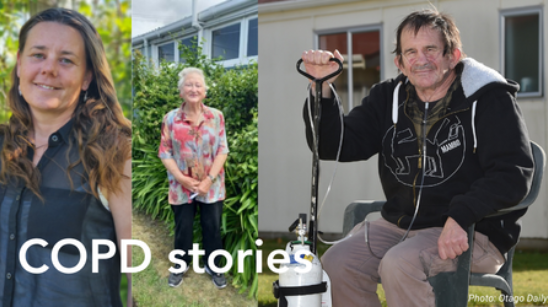
Understanding COPD
COPD is a condition that affects over 200,000 Kiwis but remains woefully undiagnosed. COPD is the fourth most common cause of death in New Zealand, and the third most common cause of death in the Māori population.
With World COPD Day recently held on November 18, and NZ’s first ever COPD Guidelines soon to be published - raising awareness for the condition is key. Foundation Research and Education Manager, Joanna Turner, helps demystifies the condition below, and provides some helpful advice on how to live life to the fullest with the condition.
What is COPD? COPD stands for chronic obstructive pulmonary disease. It’s an umbrella term used for long term respiratory diseases including emphysema, chronic bronchitis and chronic airflow obstruction.
Living with COPD means that the breathing passages (airways) in your lungs are compromised and the lung tissue is damaged, making it hard to breathe or catch your breath.
It’s estimated that 15% of adults over the age of 45 suffer from COPD in New Zealand, but many don’t know they have it, or know anything about it.
What are the symptoms? COPD can be mild, moderate or severe depending on how badly damaged the lungs are. When a person starts to experience symptoms, such as shortness of breath, difficulty breathing (especially with exercise), a cough, presence of phlegm, bronchitis and wheezing – this means the damage has already occurred and unfortunately cannot be reversed.
Even simple activities like walking, bending down, showering and hanging out the washing can cause breathlessness. This can be very frightening for people, especially if breathlessness becomes out of control.
What causes it? Smoking is the most common cause of COPD, and this includes being exposed to secondhand smoke for long period of time. Unfortunately, the damage occurs over a number of years, and symptoms don’t become noticeable until over the age of 40, when the damage has already occurred. Some people can also develop COPD from being exposed to noxious particles in the air, such as pollution, contaminants, dust, or chemicals.
How is it treated? COPD treatment focuses largely on relieving symptoms through medication and effective management strategies. People can also make themselves feel better through regular physical activity, eating a balanced diet, conserving their energy if tired, managing breathlessness by developing breathing control techniques, developing a COPD action plan (self-management plan) alongside a health professional, minimising stress, and having support from family and friends.
Being diagnosed with COPD will inevitably change a person’s life, however, by taking some steps to manage day-to-day activities, some of the anxiety and discomfort that is often associated with a COPD diagnosis can be minimised.
Breathlessness Strategies for COPD
If you have COPD and are experiencing breathlessness, there are several different breathing techniques that can be used to manage this. Practice each technique to find out what suits you best.
Breathing Control/Tummy Control: Place hands on tummy, breathe in (tummy goes out), breathe out (tummy goes in)
Pursed-Lip Breathing: Breathe in through your nose, breathe out like through a straw
Blow as you Go: Breathe in before exerting effort, breathe out while making the effort
Paced Breathing: Breathe in for a few counts, breathe out for a few counts
Breathe around the rectangle: Find a rectangular object such as a door frame and breathe in along the short side, and out along the long side.




